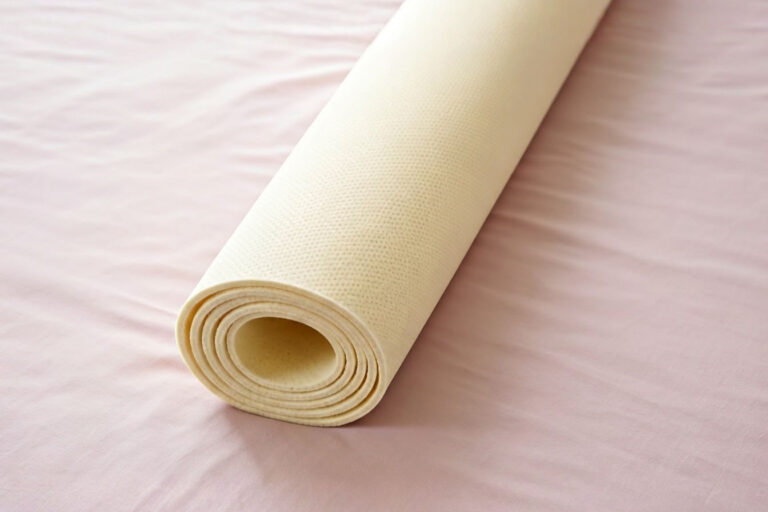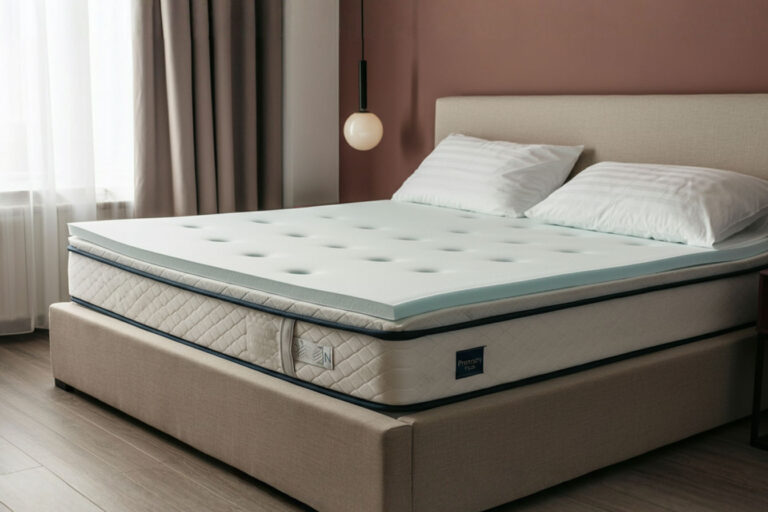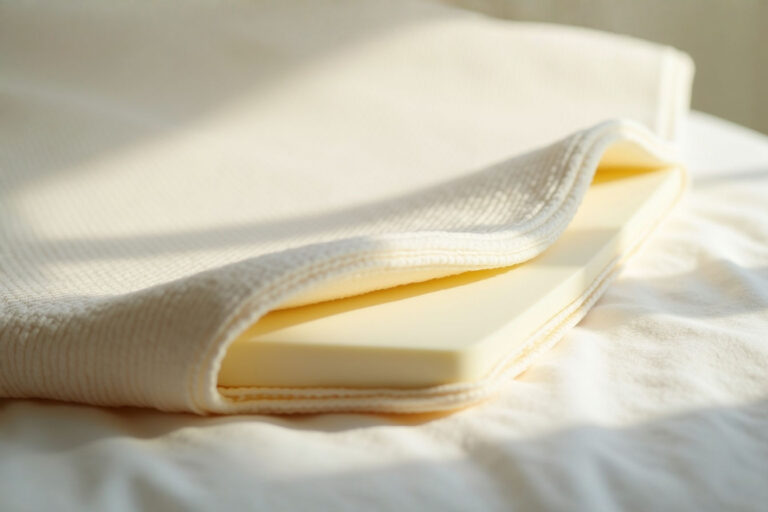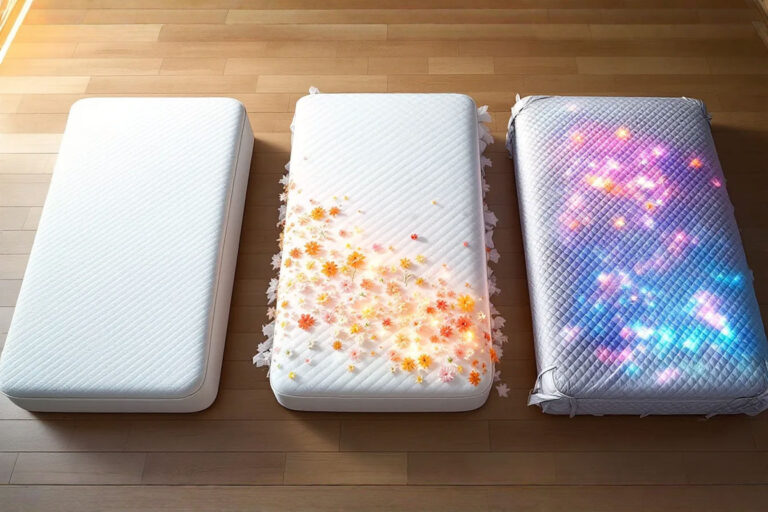Latex Mattress Topper vs. Memory Foam: Which Provides Better Support for Heavy Sleepers?
Heavy sleepers need specialized support from their mattress toppers. This guide compares how latex and memory foam perform for weights over 230 pounds, revealing which material offers better long-term value.
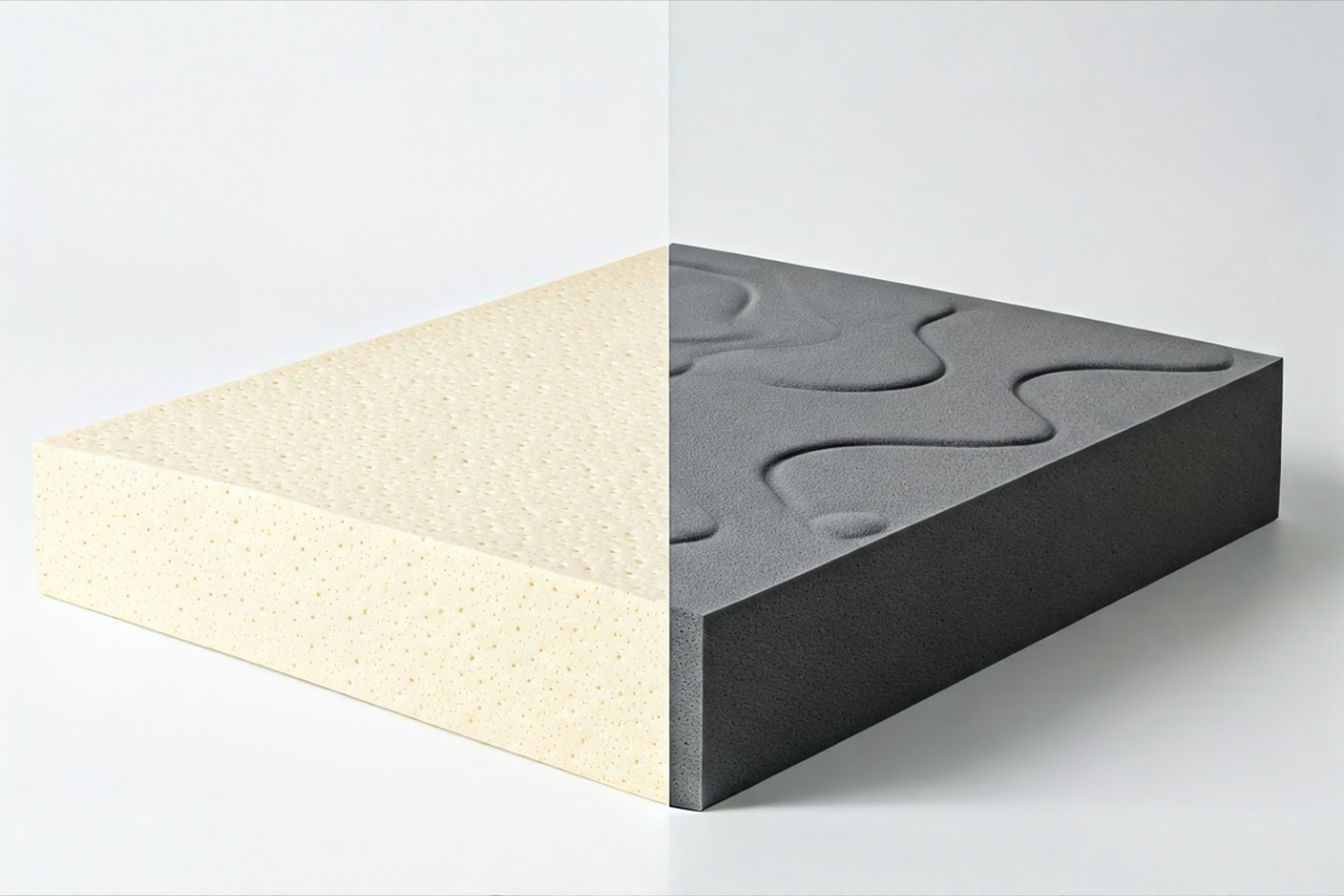
The quest for a good night’s sleep presents unique challenges when you carry more weight than average. Your body requires exceptional support, pressure relief, and durability from sleep surfaces that standard mattresses often fail to provide. Adding a high-quality mattress topper represents a cost-effective solution that can transform an uncomfortable bed into a supportive sleep sanctuary without the expense of a complete mattress replacement.
Two materials dominate the premium mattress topper market: latex and memory foam. Both offer distinct advantages for heavier individuals, but their performance characteristics differ significantly. This comprehensive guide examines how these materials compare specifically for sleepers weighing over 230 pounds, helping you determine which option will best address your particular sleep needs and preferences.
By the end of this article, you’ll understand the critical differences between latex and memory foam toppers, their respective strengths and limitations for supporting higher weights, and how to select the ideal option based on your sleep position, comfort preferences, and budget considerations.
Understanding the Needs of Heavy Sleepers
Before comparing specific materials, it’s essential to recognize the unique requirements heavier individuals face when selecting sleep surfaces. The term “heavy sleeper” typically refers to individuals weighing over 230 pounds, though sleep needs vary significantly based on weight distribution, body composition, and personal comfort preferences.
Individuals carrying more weight place greater pressure on sleep surfaces, which can lead to excessive sinkage, improper spinal alignment, and accelerated wear of materials. Adequate support becomes paramount to prevent the development or worsening of back pain, joint discomfort, and sleep quality issues. Heavier sleepers often report problems with excessive heat retention, difficulty changing positions, and premature deterioration of standard mattress toppers.
A suitable topper for heavier individuals must effectively distribute weight, resist compression over time, maintain proper spinal alignment, and ideally regulate temperature. The material should also offer sufficient durability to withstand the additional pressure without quickly developing permanent indentations or losing its supportive properties.
Key Properties of Latex Mattress Toppers
Latex toppers have gained popularity for their exceptional resilience and natural composition. These products come in several varieties, each offering distinct advantages for heavier sleepers.
Natural latex derives from the sap of rubber trees and undergoes processing through either the Dunlop or Talalay method. Dunlop latex provides a denser, firmer feel with excellent durability, making it particularly suitable for supporting higher weights. Talalay latex features a lighter, more consistent cell structure with enhanced breathability, though typically at a higher price point. Synthetic latex and blended options offer more affordable alternatives but generally sacrifice some performance characteristics.
The responsive nature of latex creates an immediate bounce-back effect when pressure is applied and removed. This responsiveness prevents the sinking sensation that many heavier sleepers find problematic with other materials. The material’s inherent resilience helps maintain proper spinal alignment by supporting the body’s heavier regions while conforming enough to relieve pressure points.
Temperature regulation represents another significant advantage of latex for heavier individuals who often sleep warmer. The natural open-cell structure of latex promotes airflow, helping dissipate body heat throughout the night. This breathability makes latex an excellent option for those who tend to sleep hot or live in warmer climates.
Durability stands out as perhaps the most compelling feature of latex for heavier sleepers. High-quality latex toppers can maintain their supportive properties for 7-10 years or longer, significantly outlasting most other topper materials. This exceptional longevity often justifies the higher initial investment, especially for those placing greater demands on their sleep surfaces.
The density of latex toppers ranges from soft to extra-firm, with medium-firm to firm options (ILD ratings of 32-38) typically providing the ideal balance of support and comfort for heavier individuals. Thicknesses between 3-4 inches generally offer sufficient depth to enhance comfort without compromising support.
For those with allergies or environmental concerns, natural latex provides additional benefits. The material is naturally resistant to dust mites, mold, and mildew. Many manufacturers also emphasize sustainable harvesting and production methods, though these premium options command higher prices.
Key Properties of Memory Foam Toppers
Memory foam revolutionized the mattress industry with its distinctive pressure-relieving properties, and memory foam toppers continue to be popular options for enhancing sleep surfaces. For heavier individuals, however, not all memory foam toppers perform equally.
Traditional memory foam consists of polyurethane enhanced with chemicals to increase viscosity and density. When exposed to body heat, the material softens and conforms precisely to body contours. This exceptional contouring ability provides unmatched pressure relief by distributing weight evenly across the sleep surface. For heavier sleepers experiencing pain at pressure points like shoulders and hips, this conforming nature can provide significant relief.
The density of memory foam proves crucial for determining its suitability for higher weights. Density measures the weight of one cubic foot of foam, with higher numbers indicating more material and typically better durability and support. For individuals weighing over 230 pounds, memory foam toppers with densities of at least 5 pounds per cubic foot offer the necessary resilience to prevent excessive sinkage and premature deterioration.
Heat retention has traditionally been memory foam’s greatest drawback, particularly problematic for heavier individuals who already tend to sleep warmer. Modern variations address this limitation through various technologies. Gel-infused memory foam incorporates cooling gel particles or layers to help dissipate heat. Open-cell structures enhance breathability, while copper and graphite infusions utilize these materials’ natural thermal conductivity to pull heat away from the body.
Motion isolation represents a significant advantage of memory foam. The material absorbs movement rather than transferring it across the surface, making it an excellent choice for couples where one partner is heavier or tends to change positions frequently during sleep.
The slow-responding nature of memory foam creates both advantages and challenges for heavier sleepers. While this characteristic enhances pressure relief and motion isolation, it can make changing positions more difficult and create a sensation of being “stuck” in the material. This effect becomes more pronounced as body weight increases.
Durability concerns make density selection particularly important. Lower-density memory foam toppers may provide initial comfort but often develop permanent body impressions within months when supporting higher weights. High-density options (5+ lbs/ft³) typically maintain their supportive properties for 3-5 years before showing significant deterioration.
Recent innovations include memory foam formulations that address traditional limitations. Plant-based memory foams replace some petroleum-based ingredients with plant-derived oils, potentially reducing chemical odors and enhancing breathability. Response-modified foams aim to deliver memory foam’s pressure relief with improved responsiveness similar to latex.
Direct Comparison: Support Factors for Heavy Sleepers
When evaluating support characteristics specifically for heavier individuals, several key factors determine how effectively each material performs.
Weight distribution capability directly impacts comfort and spinal alignment. Latex distributes weight through its natural resilience, supporting the body while providing gentle pushback. Memory foam distributes weight through complete conforming, essentially creating a customized surface that fills every space between the body and topper. Both approaches can work effectively, though latex typically prevents excessive sinkage better for weights over 275 pounds.
Sinkage depth varies significantly between materials. Medium-firm to firm latex allows approximately 1.5-2.5 inches of compression for heavier individuals, maintaining a supportive sleep surface while still relieving pressure points. Memory foam may allow 2.5-4 inches of sinkage, which some heavier sleepers find creates better pressure relief but others report causes difficulty with movement and alignment.
Spinal alignment concerns affect sleep quality and pain management. Proper alignment keeps the spine in a neutral position throughout the night, preventing stress on muscles and joints. Latex’s responsive support often maintains better alignment for back and stomach sleepers carrying extra weight, while memory foam’s deeper contouring can benefit side sleepers by accommodating wider shoulder and hip areas.
Edge support determines how well a topper maintains its supportive properties across the entire surface. Latex generally provides superior edge support, allowing full use of the sleep surface without the sensation of rolling off. Memory foam typically compresses more significantly at edges, which can reduce usable sleep space—a particular concern for heavier individuals who require more room.
Support longevity under higher weights favors latex significantly. The material’s cellular structure resists compression substantially better than memory foam, resulting in fewer permanent indentations and longer-lasting support. This resilience becomes increasingly important as body weight increases and places greater strain on the topper.
Recovery speed affects how quickly a material returns to its original shape after pressure is removed. Latex rebounds almost instantly, while traditional memory foam may take 20-60 seconds to recover completely. This difference impacts ease of movement during sleep, with latex allowing more effortless position changes—an important consideration for heavier individuals who may already experience reduced mobility.
Comfort Considerations Beyond Support
While support remains paramount for heavier sleepers, comfort factors significantly influence overall satisfaction and sleep quality.
Temperature regulation often becomes more critical as body weight increases due to greater heat production and reduced air circulation around the body. Latex maintains a significant advantage in this area, with its naturally breathable structure allowing consistent airflow throughout the night. Even enhanced cooling memory foams typically retain more heat than latex alternatives, though they perform substantially better than traditional memory foam formulations.
Pressure relief approaches differ between materials. Memory foam eliminates pressure points through complete conforming, essentially removing gaps between the body and sleep surface. This characteristic can provide exceptional relief for heavier individuals suffering from joint pain or those who primarily sleep on their sides. Latex relieves pressure through gentle compression while maintaining more support, which typically works better for back and stomach sleepers.
Body impression resistance directly impacts comfort longevity. High-quality latex toppers show minimal permanent indentation even after years of supporting higher weights. Memory foam, even in higher densities, typically develops more noticeable body impressions over time. These impressions can affect comfort and support, potentially exacerbating alignment issues.
Initial adjustment periods vary between materials. Many users report an immediate comfort improvement with latex toppers, while memory foam often requires a break-in period of 2-4 weeks as the material softens and the body adapts to its unique feel. Heavier individuals may accelerate this break-in period but should still allow time for proper adjustment.
Sleeping position compatibility influences material selection based on individual preferences. Side sleepers generally benefit from memory foam’s deeper pressure relief at shoulders and hips, areas where heavier individuals concentrate more weight. Back sleepers often prefer latex’s balance of conforming comfort with supportive pushback. Stomach sleepers typically need the firmest options in either material to prevent excessive sinkage that could misalign the spine.
Material Durability and Longevity
For heavier individuals, topper durability directly impacts both satisfaction and value. The materials show significant differences in their ability to maintain supportive properties under higher weights.
Expected lifespan for high-quality natural latex toppers typically ranges from 7-10 years, even when supporting weights over 230 pounds. This exceptional durability stems from latex’s inherent resilience and resistance to cellular breakdown. In contrast, high-density memory foam toppers generally maintain their supportive characteristics for 3-5 years before showing significant deterioration when supporting similar weights.
Compression resistance over time heavily favors latex. The material’s molecular structure allows it to recover from compression thousands of times with minimal permanent changes. Memory foam, particularly in lower densities, develops more lasting compression sets as its cell structure gradually breaks down under repeated pressure. This difference becomes more pronounced as body weight increases.
Warranty considerations reflect these durability differences. Many premium latex toppers come with warranties of 5-10 years covering significant indentations (typically defined as depressions deeper than 3/4 inch). Memory foam topper warranties typically range from 1-5 years with similar coverage terms. However, warranty claims often involve complicated processes and may not fully address gradual softening that affects comfort without creating visible indentations.
Value assessment considering lifespan often favors latex despite its higher initial cost. When calculating cost per year of use, many heavier sleepers find that latex toppers ultimately provide better value through their extended useful life. A $400 latex topper lasting 8 years costs approximately $50 per year, while a $200 memory foam topper lasting 4 years costs the same annually but requires replacement sooner.
Environmental impact varies between options. Natural latex represents a renewable resource when harvested sustainably, and many manufacturers emphasize eco-friendly processing methods. Memory foam derives from petrochemicals and typically contains more synthetic compounds, though plant-based variations offer somewhat improved environmental profiles.
Thickness and Density Guidelines
Selecting appropriate thickness and density specifications proves especially important for heavier individuals seeking optimal support and comfort.
For latex toppers, thickness recommendations range from 2-4 inches, with 3 inches representing the ideal balance for most sleepers over 230 pounds. This thickness provides sufficient depth to enhance comfort while maintaining the supportive benefits of the underlying mattress. Those weighing over 275 pounds may benefit from 4-inch options, particularly when placing the topper on older or softer mattresses.
Density in latex toppers correlates with firmness level and durability. Medium-firm to firm options (ILD ratings of 32-44) typically provide the ideal support for heavier individuals. Dunlop latex, with its denser composition, generally outperforms Talalay varieties for supporting higher weights, though both can work effectively in appropriate specifications.
Memory foam thickness guidelines shift slightly higher, with 3-4 inches recommended for individuals over 230 pounds. The additional depth accommodates the material’s deeper compression characteristics while providing sufficient distance from the underlying mattress. Toppers less than 3 inches thick often “bottom out” for heavier individuals, negating their pressure-relieving benefits.
Density specifications prove absolutely critical for memory foam performance under higher weights. For sleepers over 230 pounds, memory foam densities below 5 pounds per cubic foot typically deteriorate too quickly to provide lasting value. Those weighing over 275 pounds should consider ultra-high-density options (6+ lbs/ft³) despite their higher cost and potential for increased heat retention.
Foundation interactions influence topper performance significantly. Both materials perform best when placed on relatively firm, non-sagging mattress surfaces. Adding either topper type to an already compromised mattress with significant indentations may initially improve comfort but won’t resolve fundamental support issues and may accelerate the topper’s deterioration.
Health and Wellness Factors
Beyond physical support, both materials offer distinct health considerations that may influence selection.
Allergy considerations favor natural latex for some individuals. While approximately 1% of the population has latex allergies, most reactions relate to direct skin contact with latex proteins. Mattress-grade latex undergoes washing processes that remove most allergenic proteins, and covering the topper with an allergen-proof encasement virtually eliminates exposure risk. Memory foam rarely causes allergic reactions but may emit chemical odors that sensitive individuals find problematic.
Respiratory impacts relate primarily to off-gassing—the release of volatile organic compounds (VOCs) from newly manufactured foam products. Memory foam typically produces stronger initial odors that dissipate over several days to weeks. Some sensitive individuals report headaches, respiratory irritation, or sleep disruptions during this off-gassing period. Natural latex produces significantly fewer emissions, though synthetic latex may exhibit similar off-gassing to memory foam.
Joint and back pain relief approaches differ between materials. Memory foam’s complete contouring eliminates pressure points by conforming exactly to body contours, which many find effective for joint pain relief. Latex provides more supportive pushback while still conforming enough to alleviate pressure, often working better for back pain that stems from poor alignment rather than pressure sensitivity.
Sleep quality improvements reported by heavier individuals often emphasize temperature regulation and ease of movement with latex, versus superior pressure relief and motion isolation with memory foam. Personal comfort preferences ultimately determine which characteristics contribute most significantly to improved sleep.
Making Your Decision: Key Factors to Consider
When selecting between latex and memory foam toppers as a heavier sleeper, prioritizing your specific needs and preferences will guide you toward the most satisfying option.
Budget considerations cannot be separated from longevity expectations. While latex toppers typically cost 40-60% more initially, their extended useful life often delivers better long-term value for those weighing over 230 pounds. High-quality natural latex toppers generally range from $300-800 depending on size and specifications, while comparable memory foam options typically cost $180-500.
Existing mattress condition significantly impacts topper performance. Neither material can fully compensate for a severely sagging or deteriorated mattress. However, both can effectively enhance a mattress that remains structurally sound but lacks adequate comfort layers or has begun to feel slightly firmer or less comfortable than when new.
Primary sleep concerns should guide material selection. Those prioritizing temperature regulation, ease of movement, bounce, and long-term resilience typically prefer latex. Individuals seeking maximum pressure relief, motion isolation, and body-conforming properties often choose memory foam despite its shorter lifespan.
Personal comfort preferences ultimately override general guidelines. Some heavier individuals simply prefer the feel of one material over the other, regardless of theoretical advantages. When possible, experiencing both materials before purchasing provides the most reliable basis for decision-making.
Trial periods and return policies gain importance given the subjective nature of comfort preferences. Many premium topper manufacturers now offer sleep trials ranging from 30-100 nights, allowing in-home testing before committing. Verify that return shipping costs and any potential restocking fees would not make returns prohibitively expensive.
Installation and Maintenance
Proper handling, installation, and maintenance significantly impact topper performance and longevity, particularly for heavier individuals placing greater demands on these materials.
Setup differences between materials affect initial impressions. Latex toppers arrive ready for immediate use without an off-gassing period, though their substantial weight (a queen size typically weighs 25-40 pounds) can make handling challenging. Memory foam toppers usually require 24-72 hours to fully expand after unpacking and may emit noticeable odors during this period, necessitating good ventilation.
Cleaning and care guidelines emphasize protection. Neither material should be directly washed; instead, using a waterproof, breathable topper encasement prevents stains and contamination while preserving airflow. Spot cleaning with mild detergent and water works for small accidents, but both materials can be damaged by soaking or machine washing.
Rotation recommendations help prevent uneven wear. Rotating toppers 180 degrees every 3-6 months distributes compression more evenly across the surface. Some latex toppers can also be flipped (if not constructed with distinct top and bottom layers), further extending their useful life. Memory foam toppers typically have a designated sleeping surface and should not be flipped.
Proper support foundation ensures optimal performance. Both materials perform best on flat, stable surfaces rather than widely spaced slats that may allow excessive sagging. If using an adjustable base, ensure the topper has sufficient flexibility to adapt to different positions without creating stress points that accelerate deterioration.
Conclusion
For heavier sleepers seeking improved support and comfort, both latex and memory foam toppers offer viable solutions with distinct advantages. The ideal choice depends on your specific priorities, sleep preferences, and long-term value expectations.
Latex toppers excel in support, temperature regulation, responsiveness, and durability—characteristics that often prove particularly beneficial for those carrying more weight. While demanding a higher initial investment, their exceptional longevity typically delivers superior value over time. The material’s natural resilience prevents excessive sinkage while still providing sufficient conforming for pressure relief, making it especially suitable for back and stomach sleepers or those who prioritize ease of movement.
Memory foam toppers provide unmatched pressure relief through precise contouring, exceptional motion isolation, and typically lower initial costs. Their gradual response to body heat and pressure creates a distinctive “hug” that many find exceptionally comfortable, particularly side sleepers with sensitive joints. However, their shorter lifespan under higher weights and potential for heat retention represents significant considerations.
For the majority of sleepers weighing over 230 pounds who place emphasis on durability and temperature regulation, latex toppers typically offer the most satisfying long-term solution despite higher upfront costs. Those with specific pressure sensitivity issues or who primarily sleep on their sides may find memory foam’s unique characteristics worth the trade-off in longevity.
Regardless of material choice, selecting appropriate thickness, density, and firmness specifications based on your weight and comfort preferences significantly impacts satisfaction with either option. Investing in the highest quality your budget allows generally yields the best results, particularly for heavier individuals who place greater demands on sleep surfaces.
FAQs
What thickness of topper should someone over 250 pounds choose?
For individuals weighing over 250 pounds, a minimum thickness of 3 inches is recommended for either latex or memory foam toppers. Those approaching or exceeding 300 pounds should consider 4-inch options for adequate cushioning depth without bottoming out against the underlying mattress.
How long can I expect a topper to last if I’m heavier?
High-quality natural latex toppers typically maintain their supportive properties for 6-8 years under weights exceeding 250 pounds. Premium high-density memory foam (5+ lbs/ft³) generally provides 3-4 years of effective support before showing significant deterioration when supporting similar weights.
Can a topper fix my sagging mattress if I’m a heavier person?
While toppers can improve comfort on slightly worn mattresses, they cannot fully compensate for significant sagging or structural deterioration. If your mattress has visible depressions deeper than 1.5 inches, investing in a new mattress designed for higher weights likely provides better long-term results than adding a topper.
Should heavy sleepers choose firm or medium-firm toppers?
Most sleepers over 230 pounds benefit from medium-firm to firm options (ILD 32-44 for latex, or high-density memory foam with minimal initial softness). However, side sleepers with broader shoulders and hips may find medium options (ILD 25-31 for latex) provide better pressure relief while still offering sufficient support.
Do cooling features really work for heavier individuals who sleep hot?
Cooling features show varying effectiveness for heavier individuals. Natural latex’s inherent breathability typically provides more consistent temperature regulation than gel-infused memory foam, which may initially feel cool but can saturate with heat during the night. Phase-change materials and open-cell structures offer improvements over traditional memory foam but rarely match latex’s natural cooling properties.



